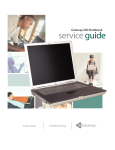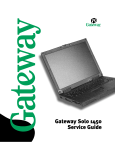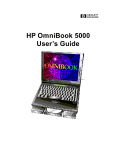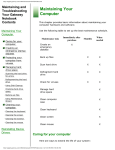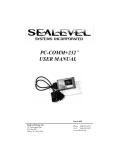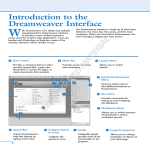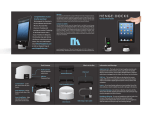Download OMNIBOOK DOCKING STATION USER MANUAL
Transcript
HP OmniBook Docking System User’s Guide 1-1 Thank you for purchasing this Factory Service Manual CD/DVD from servicemanuals4u.com. Please check out our eBay auctions for more great deals on Factory Service Manuals: servicemanuals4u Notice This manual and any examples contained herein are provided “as is” and are subject to change without notice. Hewlett-Packard Company makes no warranty of any kind with regard to this manual, including, but not limited to, the implied warranties of merchantability and fitness for a particular purpose. Hewlett-Packard Co. shall not be liable for any errors or for incidental or consequential damages in connection with the furnishing, performance, or use of this manual or the examples herein. Consumer transactions in Australia and the United Kingdom: The above disclaimers and limitations shall not apply to Consumer transactions in Australia and the United Kingdom and shall not affect the statutory rights of Consumers. © Copyright Hewlett-Packard Company 1996. All rights reserved. Reproduction, adaptation, or translation of this manual is prohibited without prior written permission of Hewlett-Packard Company, except as allowed under the copyright laws. The programs that control this product are copyrighted and all rights are reserved. Reproduction, adaptation, or translation of those programs without prior written permission of Hewlett-Packard Co. is also prohibited. Portions of the programs that control this product may also be copyrighted by Microsoft Corporation, SystemSoft Corp., and Chips and Technologies, Inc. See the individual programs for additional copyright notices. Microsoft, DriveSpace, MS, MS-DOS, and Windows are registered trademarks or trademarks of Microsoft Corporation in the United States and/or other countries (U.S. patent numbers 4955066 and 4974159). SystemSoft is a registered trademark and CardWizard, CardLite, and CardID are trademarks of SystemSoft Corporation. For warranty and regulatory information, see the Support and Service booklet. Hewlett-Packard Company Mobile Computing Division 1000 N.E. Circle Blvd. Corvallis, OR 97330, U.S.A. Edition History Edition 1 .......................................... October 1996 This manual is printed on recycled paper. 1-2 Contents Using the Docking System ................................. Understanding the Basics ................................ To set up the docking system ............................ To dock the OmniBook ................................ To undock the OmniBook .............................. To set a docking password .............................. To manually undock the OmniBook ....................... To attach a security cable .............................. To understand docking status lights ....................... Making Connections .................................... To connect an external keyboard ......................... To connect a PS/2 mouse .............................. To connect a serial mouse .............................. To switch back to the internal pointing device ................ To connect an external display .......................... To enable the built-in and external displays simultaneously ....... To connect a parallel device ............................ To connect a serial device .............................. To connect your audio equipment ........................ To connect SCSI devices ............................... To install an expansion card ............................ To remove a device from the undocked configuration .......... 1-5 1-8 1-8 1-10 1-11 1-12 1-13 1-14 1-15 1-16 1-17 1-17 1-18 1-19 1-19 1-20 1-20 1-21 1-21 1-22 1-23 1-25 Troubleshooting ......................................... Solving Problems ...................................... 1-27 1-29 Specifications and Regulatory Information .................... Regulatory Information .................................. U.S.A. ............................................ Canada ........................................... Japan ............................................ Europe ........................................... 1-33 1-35 1-35 1-36 1-36 1-37 1-3 1 Using the Docking System 1-5 Getting Started With the OmniBook Docking System, you can significantly increase the capabilities of your OmniBook. By making one connection—plugging your OmniBook into the docking system—you can get convenient access to these types of connections: ♦ ♦ ♦ ♦ ♦ ♦ ♦ ♦ 1-6 Printer. Modem or other serial device. External SCSI peripherals, such as a CD-ROM drive or disk drive. Network access cards. External keyboard and external mouse. External display. Audio connections. Power. How to Use This manual The procedures in this manual differ slightly depending on the operating system you’ve installed—Windows 95 or Windows for Workgroups. Read each step carefully to see if it applies to your operating system. What About Other Operating Systems? If you’ve installed another operating system on the OmniBook—Windows NT or OS/2 for example— follow the general procedures under Windows for Workgroups. Instead of exiting Windows (when so instructed), exit the operating system you are using. About Your OmniBook Manuals Your OmniBook provides these additional manuals: • The online OmniBook User’s Guide introduces the OmniBook and shows you how to operate and maintain your OmniBook. It also contains troubleshooting information. • The Introducing Microsoft Windows 95 manual, shipped with your OmniBook, contains information about using the standard features of Windows 95. 1-7 Using the Docking System Understanding the Basics Understanding the Basics This section shows you how to get your docking system and OmniBook up and running quickly, including how to ♦ Set up the docking system. ♦ Dock and undock the OmniBook. ♦ Manually undock. ♦ Attach a security cable to the docking system. ♦ Set a docking password. ♦ Understand the docking status lights. To set up the docking system 1. Optional: To adjust the typing angle of keyboard, you can connect the tilt legs to the docking system. Gently press inward on the tilt feet and snap on at one of the three height settings shown below. 1 2 3 1-8 Squeeze and slide to one of three height settings. Using the Docking System Understanding the Basics 2. Plug the power cord into the ac adapter, then into a grounded ac outlet. Plug ac adapter connector into the port on the back of the docking system. CAUTION Use only an HP F1140A ac adapter (the type shipped with the Docking System) —do not use an ac adapter from the OmniBook or another product. Using an improper adapter could damage the OmniBook and will make your warranty invalid. 3. Place the cable cover on the docking system. 1-9 Using the Docking System Understanding the Basics To dock the OmniBook 1. Collapse the OmniBook tilt feet. The OmniBook will not align correctly with the docking port if the tilt feet are extended. Tilt foot 2. Unplug the OmniBook’s ac adapter and cables, then close the cable door. 3. Open the OmniBook’s docking port door and slide the door under the port. 1-10 Using the Docking System Understanding the Basics 4. Place the OmniBook on the docking system and firmly push toward the docking pins until the docking system’s motor pulls the computer into the dock. To undock the OmniBook 1. Make sure ac power is connected to the docking system—red status light will be on. 2. Turn on the OmniBook (blue On/Off button). 3. If you’re using Windows 95, go to step 4. –or– If you’re using Windows for Workgroups, save your work and exit Windows. You’ll be rebooting the OmniBook. 4. Exit any applications that are using SCSI or network devices. 5. Press the Undock button on the docking system. –or– Undock button If you’re using Windows 95, you can instead select Eject PC from the Start menu. 6. If you’re using Windows for Workgroups, reboot the OmniBook after undocking. 1-11 Using the Docking System Understanding the Basics Other Controls The following picture shows the user controls on the docking system. Resets the OmniBook Turns OmniBook on and off Undocks the OmniBook To set a docking password Password security protects access to your OmniBook. If you use password security, you must enter the password at certain times (defined in Password Options). This is how to specify a docking password. 1. Press Fn+F2 to open the System Configuration Utility. The mouse does not work in this environment. 2. Press ALT+S to open the System menu, then select Passwords. 3. Under Password Options, select Undock. 4. Select Set User Password and type your password. 5. Save and exit the System Configuration Utility. 1-12 Using the Docking System Understanding the Basics To manually undock the OmniBook If for some reason you can’t undock the OmniBook using the Undock button, you can manually undock it. Manual undocking overrides password protection. To secure your OmniBook while docked, keep a Kensington MicroSaver lock attached to the security connector on the docking system. (See the following topic for instructions.) 1. Save your work and, if necessary, exit Windows. If you’re using Windows 95, be sure to use the shut down option from the Start menu. 2. Insert a key or other thin object into the security opening. 3. Press the key inward and while holding it, pull the OmniBook forward. Press firmly … …the Docking System releases the OmniBook . 4. After manually undocking the OmniBook, press the reset button on the OmniBook. 1-13 Using the Docking System Understanding the Basics To attach a security cable Your docking system has a built-in security connector that allows you to secure the docking system with a cable. Kensington MicroSaver lock systems work with these connectors and are available at many computer stores. 1. Wrap the cable around a stationary object, such as a table leg. 2. Loop the cable to create a slip knot around the stationary object—make sure it can’t slip off. 3. Insert the lock into the docking system’s security connector and release the key. Store the key in a safe place away from the OmniBook. 1-14 Using the Docking System Understanding the Basics To understand docking status lights The red and green lights on the docking system indicate the current status of the docking system. The status lights are located in the lower left corner of the docking system. This light Indicates Hard disk drive activity This light turns on when the OmniBook is reading from or writing to the hard disk drive. Floppy disk drive activity This light turns on when the OmniBook is reading from or writing to the floppy disk drive. Password protection on This light blinks when a password is required. Docking status This light turns green when the OmniBook is successfully docked, on, and can be undocked. AC power This light turns red when ac power is connected to the docking system. The light turns red and green when ac power is connected and the OmniBook is docked. 1-15 Using the Docking System Making Connections Making Connections ♦ Power (ac adapter). ♦ External keyboard. ♦ External mouse. ♦ External display. ♦ Printer or other parallel device (25-pin). ♦ Modem or other serial device (9-pin). ♦ Midi/Game port. ♦ Headphones or external speakers. ♦ External CD-ROM drive or other SCSI-2 device. ♦ Network access and other types of ISA and PCI cards (in the expansion-card slots). External audio device Line in Headphones or external speakers AC power Printer Serial SCSI Expansion card Midi Monitor Mouse 1-16 Keyboard Using the Docking System Making Connections To connect an external keyboard You can use the built-in and external keyboards while docked. 1. Attach the keyboard cable to the docking system. 2. Dock the OmniBook. Hint keyboard connector If you are using a docking system with an external keyboard, substitute the keystrokes CTRL+ALT for Fn. You must also select the option Enable External Fn key: 1. Press Fn+F2 to open the System Configuration Utility. 2. Press ALT+I to open the Input/Output menu. 3. Select External Devices. 4. Select the Enable External FN Key check box. To connect a PS/2 mouse The OmniBook has a PS/2 mouse driver installed. When you dock, the OmniBook automatically detects and sets up the mouse. 1. Attach the mouse cable to the docking system. 2. Dock the OmniBook. 3. If you’re not using Windows 95, reboot the OmniBook. mouse connector 1-17 Using the Docking System Making Connections To connect a serial mouse 1. If you’re using Windows 95, go to step 2. –or– If you’re using Windows for Workgroups, save your work and exit Windows. You’ll be rebooting the OmniBook. 2. Attach the serial mouse to the docking system. serial connector 3. Dock the OmniBook. 4. If you’re using Windows 95, go to step 5. –or– If you’re using Windows for Workgroups, reboot the OmniBook. 5. If you’re using Windows 95 • Click Start, Settings, Control Panel, Mouse, General. • Click Change, then select Standard Serial Mouse. –or– If you’re using Windows for Workgroups • From Program Manager, select Windows Setup/Change Systems Setting. • Select Serial Mouse. 1-18 Using the Docking System Making Connections To switch back to the internal pointing device Use this procedure to switch back to the built-in pointing device from an external PS/2 mouse. 1. Save your work. 2. Disconnect the mouse cable from the docking system. 3. Turn the OmniBook off, then back on. Hint You can also disable the external pointing device from the System Configuration Utility. 1. Press Fn+F2 to open the System Configuration Utility. 2. Press ALT+I to open the Input/Output menu. 3. Select External Devices. 4. Select the Ignore External Pointing Device check box. To connect an external display Use this procedure to connect an external display to your OmniBook. Before beginning, check the documentation for your display and make sure that the external display supports standard VGA or super VGA format. 1. Plug the VGA cable from the external display into the VGA connector at the back of the docking system. 2. Dock the OmniBook. The OmniBook automatically recognizes and activates the external display. The built-in display turns off. If you want to run the built-in display and an external display simultaneously, see the following procedure for instructions. VGA connector 1-19 Using the Docking System Making Connections To enable the built-in and external displays simultaneously If you enable the built-in display while running the external display, you may notice a slight dimming while the external display is connected. If the display resolutions for the two displays are not the same, panning may result. The System Configuration Utility provides a setting for turning the built-in display on and off. Docking messages are not available under-Windows 95. 1. Press Fn+F2 to open the System Configuration Utility. 2. Press ALT+I to open the Input/Output menu. 3. Select External Devices. 4. Select the Both External VGA and LCD check box. 5. Save and exit. Hint You can also use Fn+F5 to switch between the external and built-in displays. To connect a parallel device The docking system’s 25-pin parallel port is a standard enhanced (EPP/ECP) parallel port. The most common types of parallel connections involve connections to printers and to other computers. 1. Attach the parallel cable to the parallel connector. 2. Dock the OmniBook. 3. If necessary, install your printer or other device driver. See your Windows manual for instructions. parallel connector 1-20 Using the Docking System Making Connections To connect a serial device The docking system’s nine-pin serial port is a standard PC serial port. The most common types of serial connections involve printers, modems, and other computers. You can make such connections using standard serial cables and adapters available at computer dealers and electronic supply stores. Use the following procedure to connect a modem, serial printer, or serial cable. 1. Attach the serial cable to the serial connector. 2. Dock the OmniBook. serial connector To connect your audio equipment The docking system provides one output connector and two input connectors. You can connect headphones, external stereo speakers, an external audio source (such as a CD player), or an amplified microphone to the docking system. Headphones or external speakers 1. Attach the headphones or speaker cable to the audio-out connector. audio-out connector speaker switch 1-21 Using the Docking System Making Connections If up, internal speaker enabled. 2. Move the speaker switch to the up position to enable both the OmniBook’s internal speakers and the external speakers. –or– Move the speaker switch to the down position to disable the internal speaker. If down, internal speaker disabled. Microphone or external audio source (such as a CD player) • Attach an amplified microphone to the line-in (1) connector. • Attach an external audio source to the audio-in (2) connector. audio-in connector (2) line-in connector (1) To connect SCSI devices SCSI devices are disabled whenever you turn off the system or undock. 1. Make sure that each SCSI device is set to a unique SCSI ID number, ID 1 through ID 6. Do not use ID 0. See the device’s documentation for instructions for checking and changing the device’s ID. 2. Set the SCSI bus termination for each device. The device at the end of the SCSI bus must be terminated, while the devices in the middle of the bus must have their terminators removed or disabled. The device’s documentation describes how to check and change the termination. 3. Connect the peripheral devices to the docking system one after the other—a “daisy-chain” connection. 4. Plug each SCSI device into a proper electrical outlet. See the device documentation for details. 1-22 Using the Docking System Making Connections 5. If you’re using Windows 95, the OmniBook automatically detects the new device and sets it up for you. If necessary, Windows 95 requests information about the device. –or– If you’re using Windows for Workgroups e. Exit Windows. f. Dock the OmniBook. g. Reboot the OmniBook. To install an expansion card You can add up to two ISA cards, such as network (LAN) cards, to the docking system. You can add one PCI card to the docking system. If you install a PCI card, you can install only one ISA card—and it must be in the lower ISA slot. CAUTION Before removing the card from its bag, equalize static electricity by touching the bag and the port replicator’s metal back plate at the same time. Handle the card by its edges. Avoid touching electronic components. 1. Undock the OmniBook and unplug the ac adapter from the docking system. 2. Remove the cable cover and monitor stand if necessary 3. Slide the metal shield from the base. If the shield is difficult to slide, you can insert a small screwdriver into the gap between the shield and base and gently work the shield loose. Be sure to loosen the shield evenly on both the right and left sides before attempting to remove it. 1-23 Using the Docking System Making Connections 4. Unscrew and remove the slot cover next to the card slot you want to use. 5. Slide the card firmly into the connector and replace the slot cover screw. Important If you have already installed a PCI card, you can install only one ISA card—and it must be in the lower ISA slot. ISA cards PCI card 6. Replace the shield. 7. Plug in the ac adapter. 8. Replace the cable cover and dock the OmniBook. 9. If you’re using Windows for Workgroups. Install the software for the card following the manufacturer’s instructions. If the card isn’t detected, contact the card manufacturer. –or– If you’re using Windows 95 If the card isn’t detected, in Control Panel double-click Add New Hardware. Important News for Windows 95 Users If you are using Windows 95, you’ll need to remove the card you added from the undocked configuration. See the following procedure. 1-24 Using the Docking System Making Connections To remove a device from the undocked configuration When Windows 95 installs a new docking station device, it may include the device in both the docked and undocked configuration. To prevent problems when undocking, remove the device from the undocked configuration. 1. Double-click My Computer, Control Panel, System. 2. Click the Device Manager tab and find the card you installed in the list—if it is a network card, it will be under Network Adapters. 3. Select the card, then click Remove. 4. When the Confirm Device Removal box appears, select Remove From Specific Configuration. 5. Under Configuration, select Undocked, then choose OK. Confirm Device Removal Network Card Warning: You are about to remove this device from your system. Remove from all configurations. Remove from specific configuration. Undocked OK Cancel 1-25 2 Troubleshooting 1-27 Troubleshooting There are many ways to get information and technical support for your OmniBook and docking system. If you have a question about your docking system that this manual does not answer, you can try any of the following sources: • The online OmniBook User’s Guide The online manual provides complete instructions about how to operate and maintain your OmniBook. You can view the manual online or print it. • The World Wide Web The HP Web site provides a wealth of information about HP mobile-computing products. Here you can download new software and drivers, get detailed setup instructions, or view a list of common questions and answers. You can also find out how to get information and ask questions through CompuServe and America Online. The HP Web site address is http://www.hp.com/go/omnibook • Technical Support If you’d like to talk to a trained representative, you can call Technical Support. If the product is under warranty, the technical assistance is normally free. Your only charge will be the telephone call and you will speak directly to a support specialist. The Technical Support telephone number for your area is listed in the Support and Service booklet that you received with your OmniBook. • HP First (automated fax service) You can also use the HP automated fax service. Through HP First, you can access thousands of documents that provide help or information by fax. The HP First telephone number is: (800) 333-1917 (inside U.S. and Canada). (208) 344-4809 (outside U.S. and Canada). 1-28 Troubleshooting Solving Problems Solving Problems If you have a problem using the docking system, find the symptom that matches your situation. Try the suggestions one at a time. If the OmniBook won’t undock after you press the Undock button • Make sure the OmniBook is turned on. • If you’re using a password, make sure it’s accepted. • If you’re prompted about shutting down devices, and if no applications are using those devices, press ENTER. Otherwise, close those applications and try undocking again. • Reboot the system and try again. • Remove the ac adapter and let the docking system rest for 30 seconds or so, then reset and attach the ac adapter • To manually undock the OmniBook, press a key or other thin object into the security opening in the docking system. The docking system releases the OmniBook. Always reset the OmniBook after manually undocking. 1-29 Troubleshooting Solving Problems If you’re using Windows 95 and OmniBook won’t undock • Check to make sure that the network card is removed from the undocked configuration. See “To remove a device from the undocked configuration” on page 1-25. • From the Start menu, click Shut Down, then Restart the Computer in MS-DOS mode. From MS-DOS, try undocking. If the docking system makes a noise when you dock the OmniBook There is nothing wrong with the hardware. This occurs on occasion when the docking system motor pulls the OmniBook into place. If you need to replace a lost or damaged power cord For the replacement part number for the docking system power cord, contact the number in the Support and Service booklet. If a serial or parallel device or external display doesn’t work • Make sure the OmniBook is fully inserted in the docking system. The connection should be snug. • Reboot the OmniBook. If an external PS/2 mouse or keyboard doesn’t work • Make sure the OmniBook is fully inserted in the docking system. The connection should be snug. • Make sure the mouse is plugged into the correct port. The mouse and keyboard ports look the same. See page 1-17. • Turn the system off and on. • Reboot the system. • Undock the OmniBook, unplug and reconnect the ac adapter, then dock again. If the network connections don’t work • Make sure that the LAN cable is connected. • You normally lose connections when you turn off the system or undock. See if your network software has a reconnect feature. 1-30 Troubleshooting Solving Problems • Make sure you are using the appropriate drivers for the card—for a list of drivers, see the HP web site. The address is http://www.hp.com/go/omnibook. • Check your configuration files to make sure that the network drivers are properly installed. • Try undocking and docking again. • Check that there is no address or interrupt conflict. Check these settings on the network adapter—or, if the board has configuration software, check the settings using that software—see the manual for the network board. Also check these settings in your network software. If SCSI devices don’t work • If you’re using Windows for Workgroups, try rebooting and selecting a startup option that loads the SCSI drivers. • Check the device ids for conflicts. • Make sure you turn on the SCSI devices before you reboot the system. They’re configured at boot time. • Check your connections and termination. • Check your configuration files to make sure that the SCSI drivers are properly installed. • Try undocking and docking again. • Check that there is no address or interrupt conflict. The SCSI interface normally uses I/O range 3000-307F and interrupt request 10. If a network-enabled system locks up when rebooting The following suggestions apply to Windows for Workgroups only: • Edit AUTOEXEC.BAT to disable Windows for Workgroups network support for all non-network startup options. Add the /N switch to the WIN command (win /n) for each of the non-network options. • Edit CONFIG.SYS and AUTOEXEC.BAT to load network drivers only for the “Docking system” startup option, and not for undocked startup options. The following suggestions s apply to other operating systems: • Check any available online tools—Device Wizard in Windows 95, for example—or check with your system administrator. 1-31 Troubleshooting Solving Problems If your docking password isn’t accepted • Check whether Num Lock is off. • If you’ve forgotten your password, have your OmniBook at hand and call Hewlett-Packard support. See your OmniBook Support and Service booklet. 1-32 3 Specifications and Regulatory Information 1-33 Specifications and Regulatory Information Your OmniBook docking system is designed to provide trouble-free operation. The following suggestions can help you while working with your OmniBook: ♦ If you have problems, see the problem-solving suggestions and references listed in chapter 2. ♦ If you think your docking system might need repair service, see the warranty and service information in the Support and Service booklet. To contact Hewlett-Packard If you have questions that the OmniBook manuals don't answer (even after looking in the contents and index), you can contact Hewlett-Packard at the address or phone number listed in the Support and Service booklet or in OmniBook Support in the online OmniBook Library. Please have your OmniBook with you. 1-34 Specifications and Regulatory Information Regulatory Information Regulatory Information This section presents information that shows how the docking system complies with regulations in certain regions. Any modifications to the docking system not expressly approved by Hewlett-Packard could void the authority to operate the docking system in these regions. U.S.A. The docking system generates and uses radio frequency energy and may interfere with radio and television reception. The docking system complies with the limits for a Class B computing device as specified in Part 15 of FCC Rules, which provide reasonable protection against such interference in a residential installation. (With a network card installed, the docking system complies with the limits for a Class A device, which limits use to a nonresidential installation.) The “FCC ID” number for this product is listed on the bottom of the unit. In the unlikely event that there is interference to radio or television reception (which can be determined by undocking the OmniBook and unplugging the ac adapter), try the following: • Reorienting or relocating the receiving antenna. • Relocating the docking system with respect to the receiver. • Connecting the ac adapter to another power outlet. To maintain compliance with FCC Rules and Regulations, use properly shielded cables when connecting peripheral devices to this device. Use cables supplied with the OmniBook when appropriate. For more information, consult your dealer, an experienced radio/television technician, or the following booklet, prepared by the Federal Communications Commission: How to Identify and Resolve Radio-TV Interference Problems. This booklet is available from the U.S. Government Printing Office, Washington, DC 20402, Stock Number 004-000-00345-4. At the first printing of this manual, the telephone number was (202) 783-3238. 1-35 Specifications and Regulatory Information Regulatory Information Canada This digital apparatus does not exceed the Class B limits for radio noise emissions from digital apparatus as set out in the radio interference regulations of the Canadian Department of Communications. Le présent appareil numérique n'émet pas de bruits radioélectriques dépassant les limites applicables aux appareils numériques de Classe B prescrites dans le règlement sur le brouillage radioélectrique édicté par le Ministère des Communications du Canada. Japan 1-36 Specifications and Regulatory Information Regulatory Information Europe Products sold in Europe by Hewlett-Packard and its authorized dealers meet the specifications listed below. Declaration of Conformity (according to ISO/IEC Guide 22 and EN 45014) Manufacturer: Hewlett-Packard Company Address: Hewlett-Packard Co. Mobile Computing Division 1000 NE Circle Blvd. Corvallis, OR 97330 declares that the following product Product name: HP F1098B docking system Options: All conforms to the following product specifications Safety: IEC 950:1991+A1,A2 / EN 60950 (1992)+A1,A2 EMC: CISPR 22:1993 / EN 55022 (1994): Class B [1] EN 50082-1:1992 IEC 801-2:1991 / prEN 55024-2 (1992): 4kV CD, 8kV AD IEC 801-3:1984 / prEN 55024-3 (1991): 3V/m IEC 801-4:1988 / prEN 55024-4 (1992): 0.5kV signal lines, 1.0kV power lines Supplementary Information: The product herewith complies with the requirements of the EMC Directive 89/336/EEC. The HP F1140A ac adapter used with this product is disconnected from the power by unplugging the power cord from the power outlet or from the ac adapter. Therefore, the power outlet should be located close to the product and be easily accessible. [1] The product was tested in a typical configuration with HewlettPackard personal computer peripherals. Quality Department Hewlett-Packard Company Mobile Computing Division 1-37









































